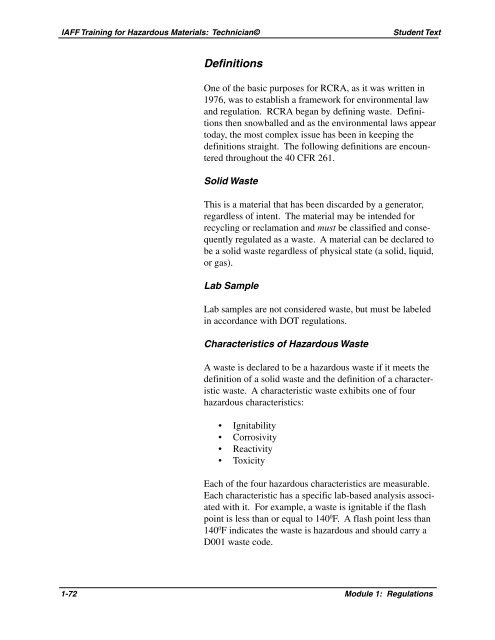Module 1: Regulations - International Association of Fire Fighters
Module 1: Regulations - International Association of Fire Fighters
Module 1: Regulations - International Association of Fire Fighters
You also want an ePaper? Increase the reach of your titles
YUMPU automatically turns print PDFs into web optimized ePapers that Google loves.
IAFF Training for Hazardous Materials: Technician© Student Text<br />
Definitions<br />
One <strong>of</strong> the basic purposes for RCRA, as it was written in<br />
1976, was to establish a framework for environmental law<br />
and regulation. RCRA began by defining waste. Definitions<br />
then snowballed and as the environmental laws appear<br />
today, the most complex issue has been in keeping the<br />
definitions straight. The following definitions are encountered<br />
throughout the 40 CFR 261.<br />
Solid Waste<br />
This is a material that has been discarded by a generator,<br />
regardless <strong>of</strong> intent. The material may be intended for<br />
recycling or reclamation and must be classified and consequently<br />
regulated as a waste. A material can be declared to<br />
be a solid waste regardless <strong>of</strong> physical state (a solid, liquid,<br />
or gas).<br />
Lab Sample<br />
Lab samples are not considered waste, but must be labeled<br />
in accordance with DOT regulations.<br />
Characteristics <strong>of</strong> Hazardous Waste<br />
A waste is declared to be a hazardous waste if it meets the<br />
definition <strong>of</strong> a solid waste and the definition <strong>of</strong> a characteristic<br />
waste. A characteristic waste exhibits one <strong>of</strong> four<br />
hazardous characteristics:<br />
• Ignitability<br />
• Corrosivity<br />
• Reactivity<br />
• Toxicity<br />
Each <strong>of</strong> the four hazardous characteristics are measurable.<br />
Each characteristic has a specific lab-based analysis associated<br />
with it. For example, a waste is ignitable if the flash<br />
point is less than or equal to 140 0 F. A flash point less than<br />
140 0 F indicates the waste is hazardous and should carry a<br />
D001 waste code.<br />
1-72 <strong>Module</strong> 1: <strong>Regulations</strong>
















